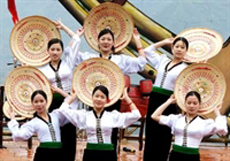The traditional dances of the Thai ethnic minority in Vietnam reflect the hill tribe's wish for a happy life of peace and prosperity.
 In a quiet valley, seven kilometers from Son La Town in Son La Province, there is a lush, bucolic beauty all around. The jungle mingles with the newly planted forest, which is well tended and protected by the local Thai hill tribe. Sparkling streams flow down the surrounding mountains where young Thai girls can be seen fetching water.
In a quiet valley, seven kilometers from Son La Town in Son La Province, there is a lush, bucolic beauty all around. The jungle mingles with the newly planted forest, which is well tended and protected by the local Thai hill tribe. Sparkling streams flow down the surrounding mountains where young Thai girls can be seen fetching water.
The valley is just a scattering of stilt-houses which look spacious and beautiful against the backdrop of the rolling hills and imposing mountainside. Local people who used to keep their cattle underneath the houses now keep cattle-pens further away from the settlement as they have been advised by the government. Each house has a tank of clean water supplied by the local reservoir.
In Tong hamlet, eight-year-old Leo Thi Vi is being taught a traditional dance called Mua xoe by her mother. Next year, she will join the village's dance troupe and perform in Hanoi for the celebration of the 1000th anniversary of Thang Long - Ha Noi.
"I like this dance very much," says Vi. "My mother told me that this dance is important to Thai people. I have seen them dancing during harvest time and New Year celebrations."
The dance is performed to welcome a bumper harvest of rice and corn. Dressed in traditional attire, Thai women always invite visitors to participate. It is ebullient music and a great way for hosts to have fun with guests.
When people get tired, they are invited to sip ruou can, the sweet rice alcohol kept in a large, bulbous jar and drunk through bamboo straws. The atmosphere is happy, if not boisterous, especially during a harvest festival. The party can keep going through the night.
Besides dancing, women also sing lyrical songs praising the beautiful scenery of their native land while wishing for good weather in order to ensure bountiful crops.
Vi's grandmother, 70-year-old Loc Hoa Xuyen, says that although there were 32 variations of the traditional dance in the past, only a few remain nowadays. Different versions suit the changing mood of the evening.
"The Xoe vong (a dance with joined hands) is boisterous, while the Xoe non (a dance with conical hats) is gentle and the Xoe dieu (a dance with both hands and body movements) is graceful", says Xuyen, who has taught traditional dancing in her community for 50 years.
In her opinion the most beautiful dance is Xoe non as the dancers' hats collectively open to create a giant forest of white flowers.
"The hats move around concealing the dancers' faces like dancing butterflies. It's a very bewitching dance for audiences to watch", the old woman says.
Xoe vong is the most popular dance as it demonstrates community solidarity and can be performed by as few as two or as many as a few hundred people. The dancers form a human circle while moving in time to the music.
If there is one circle of dancers, it moves counterclockwise around a fire. If there is more than one circle, the circles will move in opposite directions to be joined by people of all ages and social backgrounds.
In Muong Lo, Yen Bai province, women have a dance called Xoe kham khan moi lau in which dancers slowly lift up a handkerchief to reveal a bowl of liquor for guests to drink. No one can refuse this as it is a way to show respect and hospitality.
Another dance Xoe don hon symbolises the importance of maintaining loyalty despite living a hard life. The dance Xoe pha xi is performed by a group of dancers, and symbolises the importance of never forgetting one's family or native land even if you travel to the furthest corners of the world.
For Xoe om lom top mu people clap their hands while moving around in a circle. This shows people's jubilation in the flush of success and happiness when reaping a bumper crop, welcoming in the New Year or getting married.
The culture of "xoe" dancing reflects and preserves Thai people's lifestyle and culture. The dances also reflect people's wish for a happy life of peace and prosperity.
The dances and accompanying music are truly an indispensable part of Thai culture. A Thai folk song warns that "without Xoe dancing, festivals will be meaningless, the crops of rice and maize will not be abundant and people will not be able to get married."
In the quiet valleys of the countryside, the show will always go on.